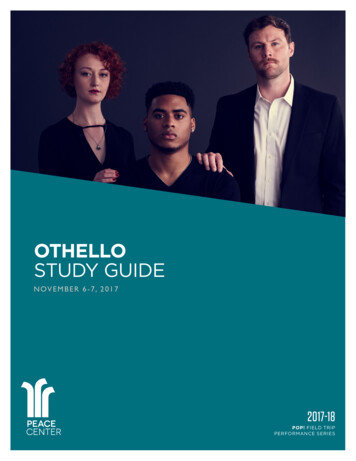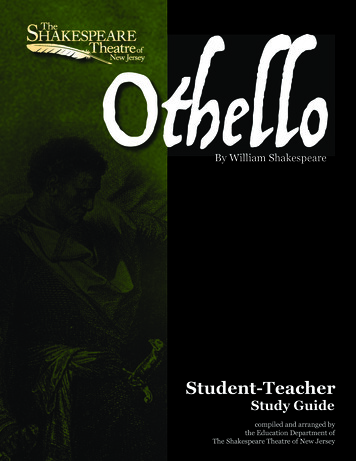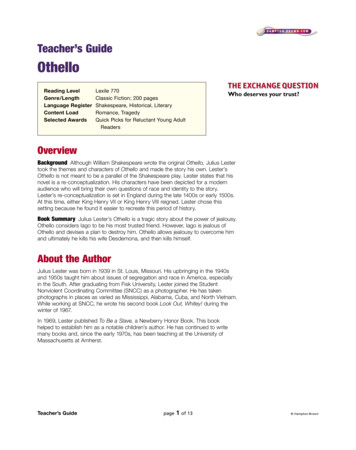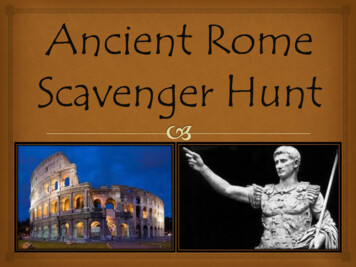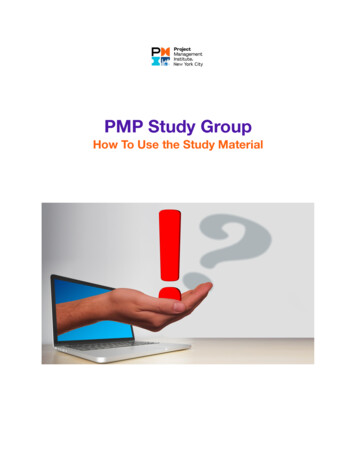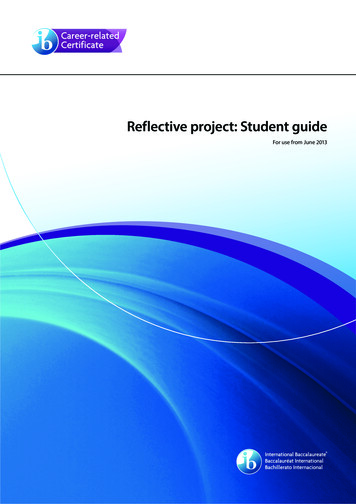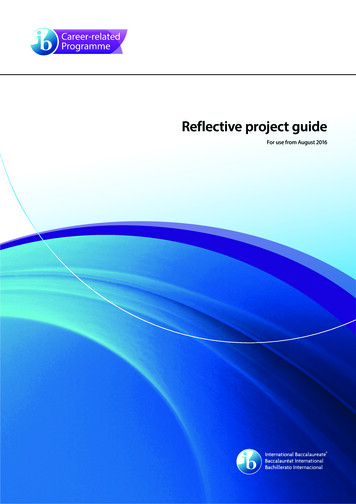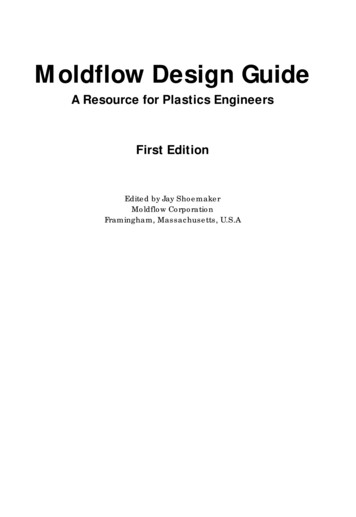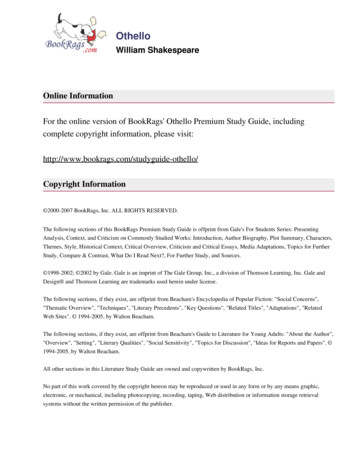
Transcription
OthelloWilliam ShakespeareOnline InformationFor the online version of BookRags' Othello Premium Study Guide, includingcomplete copyright information, please opyright Information 2000-2007 BookRags, Inc. ALL RIGHTS RESERVED.The following sections of this BookRags Premium Study Guide is offprint from Gale's For Students Series: PresentingAnalysis, Context, and Criticism on Commonly Studied Works: Introduction, Author Biography, Plot Summary, Characters,Themes, Style, Historical Context, Critical Overview, Criticism and Critical Essays, Media Adaptations, Topics for FurtherStudy, Compare & Contrast, What Do I Read Next?, For Further Study, and Sources. 1998-2002; 2002 by Gale. Gale is an imprint of The Gale Group, Inc., a division of Thomson Learning, Inc. Gale andDesign and Thomson Learning are trademarks used herein under license.The following sections, if they exist, are offprint from Beacham's Encyclopedia of Popular Fiction: "Social Concerns","Thematic Overview", "Techniques", "Literary Precedents", "Key Questions", "Related Titles", "Adaptations", "RelatedWeb Sites". 1994-2005, by Walton Beacham.The following sections, if they exist, are offprint from Beacham's Guide to Literature for Young Adults: "About the Author","Overview", "Setting", "Literary Qualities", "Social Sensitivity", "Topics for Discussion", "Ideas for Reports and Papers". 1994-2005, by Walton Beacham.All other sections in this Literature Study Guide are owned and copywritten by BookRags, Inc.No part of this work covered by the copyright hereon may be reproduced or used in any form or by any means graphic,electronic, or mechanical, including photocopying, recording, taping, Web distribution or information storage retrievalsystems without the written permission of the publisher.
Table of ContentsIntroduction.1Author Biography.2Summary and Analysis.4Act 1.4Act 2.4Act 3.5Act 4.6Act 5.7Act 1, Scene 1.8Act 1, Scene 2.10Act 1, Scene 3.11Act 2, Scene 1.13Act 2, Scene 2.16Act 2, Scene 3.17Act 3, Scene 1.20Act 3, Scene 2.22i
Table of ContentsAct 3, Scene 3.23Act 3, Scene 4.28Act 4, Scene 1.31Act 4, Scene 2.34Act 4, Scene 3.36Act 5, Scene 1.38Act 5, Scene :.43Cassio:.44Clown:.45Desdemona:.46Duke of Venice:.47Emilia:.47Gentlemen (of .51Messenger:.52ii
Table of Venice (Duke of Venice):.57Character ty.63Principal Topics.64Style.66Irony.66Chronology.67Historical Context.69The Moorish Ambassador and the Banishment of Africans.69Trade and Exploration.69iii
Table of ContentsModern Connections.71Critical Overview.74Criticism.77Critical Essay #1.78Critical Essay #2.85Critical Essay #3.101Critical Essay #4.112Critical Essay #5.123Critical Essay #6.133Critical Essay #7.137Critical Essay #8.150Critical Essay #9.166Critical Essay #10.186Media Adaptations.191iv
Table of ContentsTopics for Further Study.193Compare and Contrast.194What Do I Read Next?.195Sources for Further Study.196Literary Commentary.196Copyright Information.201v
IntroductionOthello is unique among Shakespeare's great tragedies. Unlike Hamlet, King Lear, andMacbeth, which are set against a backdrop of affairs of state and which reverberatewith suggestions of universal human concerns, Othello is set in a private world andfocuses on the passions and personal lives of its major figures. Indeed, it has oftenbeen described as a "tragedy of character"; Othello's swift descent into jealousy andrage and Iago's dazzling display of villainy have long fascinated students and critics ofthe play. The relationship between these characters is another unusual feature ofOthello. With two such prominent characters so closely associated, determining whichis the central figure in the play and which bears the greater responsibility for thetragedy is difficult. Written in 1604, Othello is one of Shakespeare's most highlyconcentrated, tightly constructed tragedies, with no subplots and little humor to relievethe tension. Although he adapted the plot of his play from the sixteenth-century Italiandramatist and novelist Giraldi Cinthio's Gli Hecatommithi, Shakespeare related almostevery incident directly to the development of Iago's schemes and Othello's escalatingfears. This structure heightens the tragedy's omi nous mood and makes the threat toboth Desdemona's innocence and the love she and Othello share more terrifying.Although narrow in scope, Othello, with its intimate domestic setting, is widelyregarded as the most moving of Shakespeare's great tragedies.Introduction1
Author BiographyWilliam Shakespeare's life was a source of mystery and controversy among scholarsof English literature. What little was known of his life was gleaned from documentaryevidence and writings of his contemporaries. Shakespeare himself left no writingsconcerning his personal life and thus remained a frustrating enigma for biographersand critics alike.Shakespeare was born to parents Mary and John Shakespeare in Stratford-upon-Avon,England. Church records show that he was baptized on April 26, 1564; from this,scholars extrapolate that he was born several days earlier, and so April 23, 1564, is thetraditional dating of his birth.Shakespeare's father was a glover and was active in town government. That JohnShakespeare's fortunes began to decline in about 1576 suggested to some scholars thatthe family may have been Catholic or had Catholic sympathies at a time whenmembership in the Church of England was required for any kind of social or financialstanding.It was assumed that Shakespear
against Othello. Othello replies that he has not stolen Desdemona but has rather legally married her, although without her father's consent. Desdemona is sent for, and when she arrives, she concurs with Othello's summary of their relationship. The duke recognizes their marriage and tells Othello that he must go to Cyprus to defend against the Turks. Othello asks that his wife accompany him, and Desdemona
